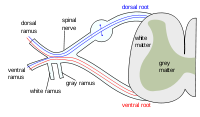
Photo from wikipedia
Introduction: In the UK, 10,000 refractory overactive bladder patients per year receive intravesical onabotulinum toxin A treatment and 300 receive sacral nerve stimulation implants. Current National Institute for Health and… Click to show full abstract
Introduction: In the UK, 10,000 refractory overactive bladder patients per year receive intravesical onabotulinum toxin A treatment and 300 receive sacral nerve stimulation implants. Current National Institute for Health and Care Excellence guidelines propose using onabotulinum toxin A before sacral nerve stimulation whilst the European Association of Urology (EAU) and American Urological Association (AUA) suggests both be offered with equipoise. The aim of this study was to ascertain both patients and clinician views regarding these two treatments. Subjects/methods: Fifty consecutive overactive bladder patients who were refractory to behavioural and medical therapy anonymously completed a structured questionnaire about their treatment preferences. Additionally, 100 UK consultant urologists anonymously completed a separate questionnaire about their treatment preferences and which treatment modalities they had available for use in their Trusts. Results: Of patients, 60% preferred sacral nerve stimulation over onabotulinum toxin A, of whom 80% would happily randomise into a trial between the two treatments. Ninety-seven per cent of 100 consultant urologists in the UK have access to onabotulinum toxin A in their hospitals, but only 39% have access to sacral nerve stimulation. Of clinicians given access to all available options, 71% would use onabotulinum toxin A as their first choice treatment for refractory overactive bladder. Conclusion: There appears to be a significant disparity between current UK overactive bladder guidance, National Health Service accessibility to onabotulinum toxin A and sacral nerve stimulation therapies, the views of clinicians, and patient preferences for treatment. Level of evidence: 5
Journal Title: Journal of Clinical Urology
Year Published: 2018
Link to full text (if available)
Share on Social Media: Sign Up to like & get
recommendations!